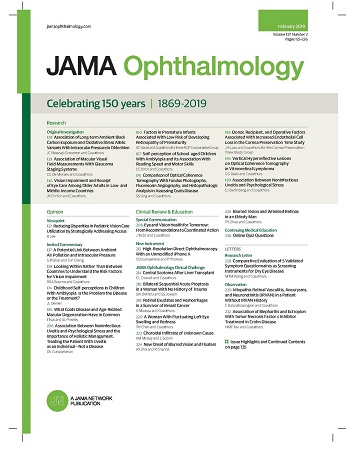Race and Vision Outcomes in Ranibizumab-Treated Participants With Diabetic Macular Edema
IF 7.8
1区 医学
Q1 OPHTHALMOLOGY
引用次数: 0
Abstract
ImportanceVision outcomes in response to anti–vascular endothelial growth factor therapy for diabetic macular edema (DME) may differ between races. This meta-analysis investigated whether vision outcomes differed among racial subgroups treated with ranibizumab for DME in a clinical trial setting.ObjectiveTo assess the impact of race on vision outcomes in participants with DME treated with ranibizumab.Data SourcesFive randomized clinical trials were preselected for analysis, including the RIDE and RISE trials (Ranibizumab Injection in Subjects With Clinically Significant Macular Edema With Center Involvement Secondary to Diabetes Mellitus); Protocol I (Intravitreal Ranibizumab or Triamcinolone Acetonide in Combination With Laser Photocoagulation for Diabetic Macular Edema), Protocol S (Prompt Panretinal Photocoagulation Versus Intravitreal Ranibizumab With Deferred Panretinal Photocoagulation for Proliferative Diabetic Retinopathy), and Protocol T (A Comparative Effectiveness Study of Intravitreal Aflibercept, Bevacizumab and Ranibizumab for Diabetic Macular Edema).Study SelectionTargeted meta-analysis of data from 5 trials.Data Extraction and SynthesisTotal enrollment numbers allowed for comparison of Black and White participants with DME who were treated with ranibizumab (0.3 mg or 0.5 mg) and had best-corrected visual acuity (BCVA) data at baseline and month 24. Lower total enrollment of participants of other races precluded statistical analysis. All ranibizumab-treated arms were pooled. Differences in vision outcomes between Black and White participants were evaluated, adjusting for baseline vision. Propensity score–matched models for participants in RIDE/RISE were used to control for differences in baseline and on-study characteristics.Main Outcomes and MeasuresMean BCVA over time and mean change from baseline at month 24 by race (Black and White).ResultsAmong the 1109 participants, the mean age was 60.0 years (95% CI, 59.4-60.7); 621 participants were male and 488 were female; 181 participants were Black and 928 were White. BCVA was better at baseline in Black vs White participants (mean Early Treatment Diabetic Retinopathy Study [ETDRS] letter score, 66.7 [95% CI, 65.0-68.4] vs 62.0 [95% CI, 61.1-62.8], respectively) but similar at month 24 (mean ETDRS letter score, 72.8 [95% CI, 70.2-75.4] vs 72.2 [95% CI, 71.2-73.1]). Mean BCVA change from baseline at month 24 was lower in Black vs White participants (6.1 ETDRS letters [95% CI, 3.6-8.6] vs 10.2 ETDRS letters [95% CI, 9.3-11.1]) and after adjusting for differences in baseline BCVA (7.7 ETDRS letters [95% CI, 5.8-9.7] vs 9.9 ETDRS letters [95% CI, 9.0-10.7]). When groups were propensity score–matched in RIDE/RISE, mean BCVA change from baseline appeared similar between Black vs White participants (10.6 ETDRS letters [95% CI, 7.1-14.1] vs 10.1 ETDRS letters [95% CI, 7.3-12.9];雷尼单抗治疗的糖尿病黄斑水肿患者的种族和视力结局
抗血管内皮生长因子治疗糖尿病性黄斑水肿(DME)的疗效可能因种族而异。这项荟萃分析调查了在临床试验中使用雷尼单抗治疗二甲醚的种族亚组的视力结果是否不同。目的评估种族对接受雷尼单抗治疗的DME患者视力结果的影响。数据来源预选了5项随机临床试验进行分析,包括RIDE和RISE试验(雷尼单抗注射治疗继发于糖尿病的临床显著黄斑水肿患者);方案I(玻璃体内注射雷尼单抗或曲安奈德联合激光光凝治疗糖尿病黄斑水肿)、方案S(快速全视网膜光凝与玻璃体内注射雷尼单抗联合延迟全视网膜光凝治疗增生性糖尿病视网膜病变)和方案T(玻璃体内注射阿非利塞普、贝伐单抗和雷尼单抗治疗糖尿病黄斑水肿的疗效比较研究)。研究选择:对5项试验的数据进行目标荟萃分析。数据提取和合成:在基线和第24个月,接受雷尼珠单抗(0.3 mg或0.5 mg)治疗并具有最佳矫正视力(BCVA)数据的DME患者中,黑人和白人的入组数允许进行比较。其他种族参与者的总入组人数较少,因此无法进行统计分析。所有的雷尼单抗组被合并。评估黑人和白人受试者视力结果的差异,并根据基线视力进行调整。RIDE/RISE参与者的倾向评分匹配模型用于控制基线和研究中特征的差异。不同种族(黑人和白人)随时间的平均BCVA和24个月时基线的平均变化。结果在1109名参与者中,平均年龄为60.0岁(95% CI, 59.4-60.7);其中男性621人,女性488人;其中黑人181人,白人928人。黑人和白人受试者在基线时BCVA更好(早期治疗糖尿病视网膜病变研究[ETDRS]平均字母评分分别为66.7 [95% CI, 65.0-68.4]和62.0 [95% CI, 61.1-62.8]),但在第24个月时相似(ETDRS平均字母评分,72.8 [95% CI, 70.2-75.4]和72.2 [95% CI, 71.2-73.1])。在调整基线BCVA差异(7.7 ETDRS字母[95% CI, 5.8-9.7] vs 9.9 ETDRS字母[95% CI, 9.0-10.7])后,黑人和白人受试者在第24个月基线时的BCVA平均变化较低(6.1 ETDRS字母[95% CI, 3.6-8.6] vs 10.2 ETDRS字母[95% CI, 9.3-11.1])。当两组在RIDE/RISE中倾向评分匹配时,黑人和白人参与者从基线开始的平均BCVA变化相似(ETDRS字母10.6 [95% CI, 7.1-14.1] vs ETDRS字母10.1 [95% CI, 7.3-12.9];P = .83)。结论和相关性这项评价雷尼单抗治疗DME的荟萃分析发现,黑人患者比白人患者的基线BCVA更好,并且在24个月时,黑人患者比白人患者的基线BCVA变化更小。2年时,黑人和白人受试者的BCVA没有差异。较小的入组人数排除了对其他种族参与者的分析,这表明在这些试验中,除了黑人和白人参与者之外,缺乏强有力的多样性。
本文章由计算机程序翻译,如有差异,请以英文原文为准。
求助全文
约1分钟内获得全文
求助全文
来源期刊

JAMA ophthalmology
OPHTHALMOLOGY-
CiteScore
13.20
自引率
3.70%
发文量
340
期刊介绍:
JAMA Ophthalmology, with a rich history of continuous publication since 1869, stands as a distinguished international, peer-reviewed journal dedicated to ophthalmology and visual science. In 2019, the journal proudly commemorated 150 years of uninterrupted service to the field. As a member of the esteemed JAMA Network, a consortium renowned for its peer-reviewed general medical and specialty publications, JAMA Ophthalmology upholds the highest standards of excellence in disseminating cutting-edge research and insights. Join us in celebrating our legacy and advancing the frontiers of ophthalmology and visual science.
 求助内容:
求助内容: 应助结果提醒方式:
应助结果提醒方式:


